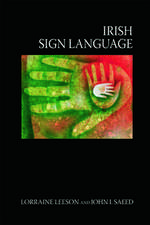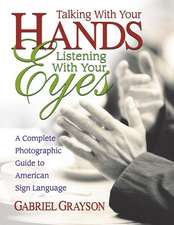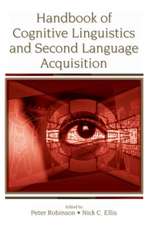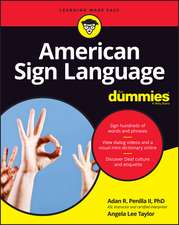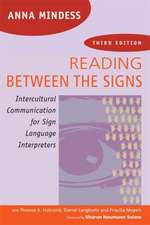Significant Gestures: A History of American Sign Language
Autor John Tabaken Limba Engleză Hardback – 29 sep 2006 – vârsta până la 17 ani
Preț: 308.33 lei
Preț vechi: 375.27 lei
-18% Nou
Puncte Express: 462
Preț estimativ în valută:
59.02€ • 64.13$ • 49.61£
59.02€ • 64.13$ • 49.61£
Carte tipărită la comandă
Livrare economică 21 aprilie-05 mai
Preluare comenzi: 021 569.72.76
Specificații
ISBN-13: 9780275989743
ISBN-10: 0275989747
Pagini: 240
Dimensiuni: 156 x 235 x 24 mm
Greutate: 0.52 kg
Editura: Bloomsbury Publishing
Colecția Praeger
Locul publicării:New York, United States
ISBN-10: 0275989747
Pagini: 240
Dimensiuni: 156 x 235 x 24 mm
Greutate: 0.52 kg
Editura: Bloomsbury Publishing
Colecția Praeger
Locul publicării:New York, United States
Notă biografică
John Tabak is a professional writer.
Cuprins
ACKNOWLEDGMENTSINTRODUCTIONCHAPTER 1 Methodological Signs and the Roots of American Sign LanguageCHAPTER 2 The Natural Language of SignsCHAPTER 3 Experiment in Television and the Last of the Great Anti-American Sign Language DebatesCHAPTER 4 The Language of the DeafCHAPTER 5 Race, Deafness, and American Sign LanguageCHAPTER 6 A Language Like Any OtherCHAPTER 7 Modern Ideas about ModalityCHAPTER 8 The Deafblind and American Sign LanguageCHAPTER 9 Some Contemporary Trends Affecting American Sign LanguageAFTERWORD The Future of American Sign LanguageNOTESINDEX
Recenzii
For some time it seemed to be the beginning of a culture, a start on a language, but it was not until those who lived the culture and used the language gained recognition as self-reliant that both the Deaf culture and American Sign Language (ASL) were acknowledged as valid. Tabak, who has a personal and professional interest in ASL, describes the remarkable French cleric who taught an early form of sign language, then traces the forces of opposition, many of which insisted on oral speech rather than signing, and describes the growth of ASL into a recognized language. He also shows the side roads, including forays into race, and how modern concepts of modality started to work for ASL. He details the path of the deaf and blind within ASL and explains technologies that are (and are not) gaining ground in the Deaf and ASL communities.










